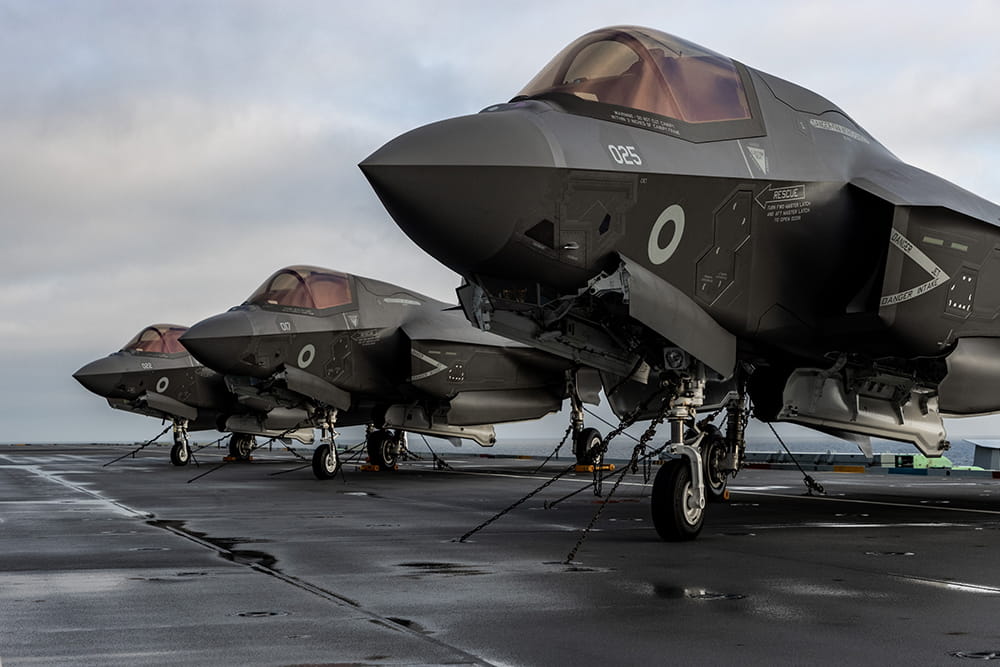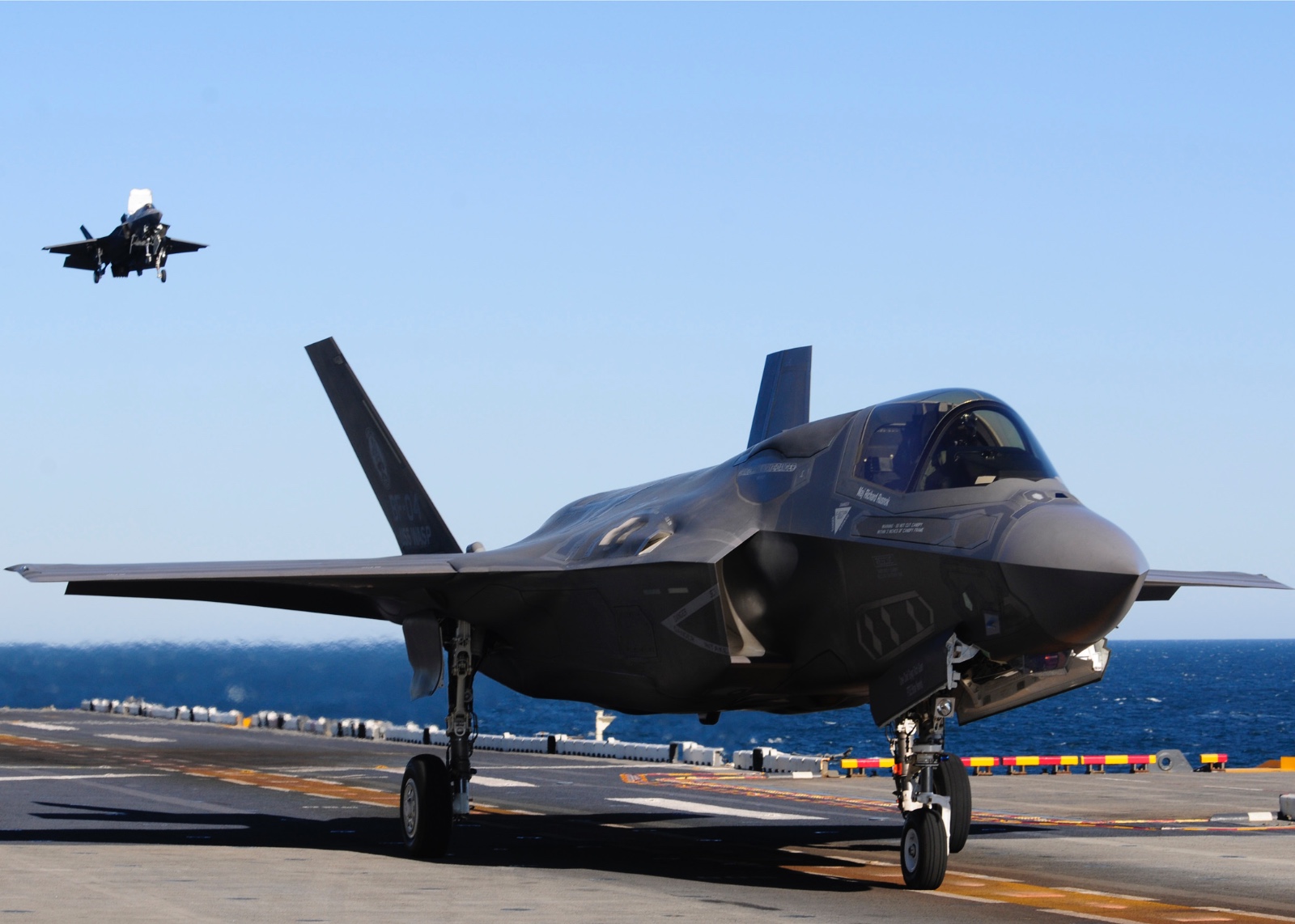The UK Carrier Strike Group, led by HMS Prince of Wales, is set to conduct ‘Exercise Strike Warrior’ off the coast of Scotland. The Royal Navy announced on October 14 that a formidable task group of warships and stealth fighters has assembled in the North Sea for exercises ahead of a significant worldwide deployment scheduled for 2025.
The official statement released by the Royal Navy stated, “For now, F-35B Lightning jets, frigates, destroyers, submarines, Royal Fleet Auxiliary tankers, and helicopters are in the North Sea as they test their ability to carry out operations seamlessly together.”
Footage was also published, showing the HMS Prince of Wales carrier launching and recovering the F-35 aircraft ahead of Exercise Strike Warrior.
In fact, the most significant part of these drills is the participation of the F-35B aircraft from the 809 Naval Air Squadron. The deck-based fighter jets will be tasked with conducting long-range strike missions, including simulated raids into mainland Europe.
The Royal Navy emphasized that “Exercise Strike Warrior is an important milestone for 809 NAS, being the Squadron’s first return to sea since the Falklands conflict and an important stepping stone in developing our Initial Operational Capability.”
Footage shows HMS Prince of Wales launching and recovering aircraft ahead of Exercise Strike Warrior. Footage by LPhot Unaisi Luke, Crown Copyright 2024. pic.twitter.com/KolH01TSm5
— UK Defence Journal (@UKDefJournal) October 14, 2024
The drills come days after a Royal Navy ‘Fast Jet Squadron’ started operating from the flight deck of a Royal Navy aircraft carrier for the first time in almost 15 years.
The Royal Navy announced in a statement on October 1 that the F-35B Lightning stealth aircraft from 809 Naval Air Squadron set out for a month-long intense training mission aboard HMS Prince of Wales in the North Sea.
The last Royal Navy fast-jet to land on a British warship was the Harrier in 2010. Soon afterward, the Harrier fleet was disbanded to make way for the induction and operation of the F-35B fighters from British aircraft carriers.
Phoenix rising, Lightning striking… :zap:
For the first time in nearly 15 years a Royal Navy fast jet squadron has embarked on a Royal Navy aircraft carrier.
F-35Bs of 809 NAS joined @HMSPWLS to prepare for Exercise #StrikeWarrior later this month. pic.twitter.com/KT5g9hpsQG
— Royal Navy (@RoyalNavy) October 1, 2024
The previous statement noted that the fifth-generation jets had a short flight from RAF Marham to the flattop, where pilots will undergo retraining to regain skills that diminished during their time away from the sea, while others will acquire the skills necessary to operate from an aircraft carrier.
The finest jet pilots of the 809 NAS will be honing vital warfighting techniques as they land and take off from the deck of the 65,000-tonne carrier, which is the equivalent of three football fields in size. The squadron was formed last year as the second of two UK front-line stealth jet squadrons.
Commander Nick Smith viewed the F-35Bs’ embarkation — accompanied by about 200 engineers, technicians, armorers, logistics and security specialists, chefs, and meteorologists, among others—as a significant milestone for the squadron.
“This is a big moment for 809 Naval Air Squadron, a vital building block to working up with the carrier strike group in preparation for the deployment next year,” said Commander Smith at the time. “To be the commanding officer of a squadron with such a proud heritage is a huge privilege. We are still in our infancy forming as an F-35B squadron, so joining a carrier for the first time is truly a milestone.”

Lieutenant Commander Armstrong, an F-35B pilot, said that although the aircraft was more advanced than the Harrier, it was still difficult to operate from a carrier.
Before setting foot on the 920-foot flight deck of HMS Prince of Wales, he and his colleagues underwent lengthy simulator training. “For me, it’s about forging one team, embracing everything from operating from the flight deck to arming and maintaining the F-35s in the hangar,” he was quoted in the press release.
He further explained, “It’s a common misconception that everything on an F-35 is automated. The aircraft will relieve you of a great deal of the workload. Landing is easier, but not easy. Imagine approaching, in the dark, 105ft above the ship, then moving across to set down on the deck.”
The deployment and training of the Fast Jet Squadron comes ahead of the carrier’s significant worldwide deployment next year. During this deployment, the aircraft carrier will lead one of the world’s most powerful carrier strike groups into the Indo-Pacific region.
Following the conclusion of Exercise Strike Warrior, the HMS Prince of Wales will proceed with her winter program, which includes a last support phase in Portsmouth before the Carrier Strike Group deployment in 2025.
Exercise Strike Warrior & Indo-Pacific Deployment
The Strike Warrior exercise aims to ensure that the task group, which consists of helicopters, frigates, destroyers, F-35B Lightning fighters, Royal Fleet Auxiliary tankers, and submarines, can work well together in a variety of environments. The Royal Air Force (RAF) is also playing a major role, supplying aircraft to support anti-submarine operations and evaluating the task group’s air defense capabilities.
The Astute-class submarine, along with several Royal Navy vessels, including HMS Portland, HMS Iron Duke, and HMS Dauntless, will protect the HMS Prince of Wales during the two-week Strike Warrior exercise.

During the drills, the task force will encounter a range of scenarios over the next two weeks intended to assess their capability to defend the carrier and carry out intricate flying operations.
The exercise involves tight coordination with NATO warships, especially those from Standing NATO Maritime Group 1 and testing the operational capabilities of the UK’s Carrier Strike Group.
Their participation offers a chance to test combined tactics in situations including air defense, pilot rescues, countering uncrewed systems, and anti-submarine warfare, as they are one of NATO’s top maritime task forces in Northern Europe.

The exercise is one of the last stages in the run-up to the carrier strike group’s Indo-Pacific deployment. Earlier this year, under the Conservative Government, the then Secretary of State for Defence of the United Kingdom, Grant Shapps, underscored that the HMS Prince of Wales was being dispatched to the Indo-Pacific region to convey a strong message opposing any attempts to undermine the rules-based international order.
The same position has been adopted by the Government, helmed by Keir Starmer. The Parliamentary Under-Secretary at the Ministry of Defense, Luke Pollard, confirmed the deployment in July 2024. “Yes, the Ministry of Defence plans to deploy HMS Prince of Wales to the Indo-Pacific in 2025,” Pollard stated when probed about the deployment.
The mission aims to strengthen defense ties and showcase the UK’s commitment to the Indo-Pacific. According to the plans laid out by the UK MoD, the UK will collaborate with Japan, the US, Australia, and Norway during the Indo-Pacific deployment.
Additionally, joint drills are believed to be important for communicating that the UK was prepared to counter challenges from around the world and believed in open commerce and travel.
Led by the HMS Prince of Wales, the Carrier Strike Group will include Royal Navy escorts and aircraft and receive assistance from two Norwegian vessels.
The United States and Japan, key members of the Quad (the Quadrilateral Security Dialogue), will conduct training exercises alongside the HMS Prince of Wales Carrier Strike Group. The deployment has been modeled after HMS Queen Elizabeth, which led the 2021 Carrier Strike Group on a 49,000-mile journey from the eastern Atlantic to Japan and back.
- Contact the author at sakshi.tiwari9555(at)gmail.com
- Follow EurAsian Times on Google News




